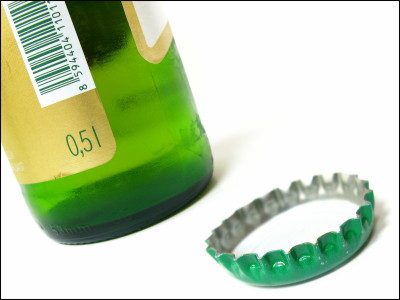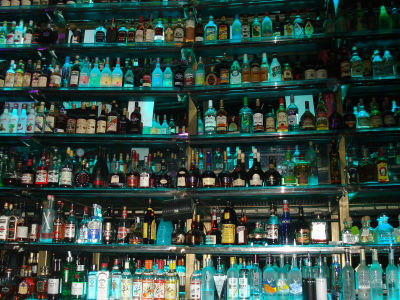Even if you drink on weekdays "Hangover free sake" that will be difficult to echo the next day may appear

When decomposing alcohol in the body, it is included in alcohol firstethanolButOxidationBe beingAcetaldehyde, The acetaldehyde is further oxidizedAcetic acidIt will eventually be decomposed into water and carbon dioxide.
The oxygen necessary for this metabolic process can be obtained through respiration and skin, but it is evident from the latest research that the decomposition of alcohol in the body is promoted by increasing the concentration of oxygen dissolved in alcohol became. In the near future, alcohol that raises oxygen concentration and sells features such as "hard to hang over" and "not left over the next day" might appear.
Details are as below.Hangover-free booze? Increasing dissolved oxygen concentrations in alcohol may reduce negative side effects
Korea·Chungnam UniversityIn a study by Professor Kwang-il Kwon of the Faculty of Pharmaceutical Sciences, the experimental result that the time required for decomposition in the body is shorter than that of an alcoholic beverage with an increased oxygen concentration compared to other alcoholic beverages. Details of the researchAlcoholism: Clinical and Experimental ResearchIt will be announced in the May issue of magazine.
"Ethanol ingested in the body is oxidized to acetaldehyde and further oxidized to water and carbon dioxide," Professor Kwang-il Kwon. "This oxidation reaction occurs mainly in the liver,Microsomal Ethanol Oxidizing System(MEOS: microsomal ethanol oxidation system)Alcohol dehydrogenase(ADH)Acetaldehyde dehydrogenase(ALDH) and other enzymescatalystwill do. Ethanol oxidation by ADH · ALDH · MEOS requires oxygen, and oxidation rate increases with higher oxygen intake "
Professor Hye Gwang Jeong, who specializes in toxicology at the School of Pharmaceutical Sciences at the Chungcheong University School of Medicine as well as Professor Kwon, said, "So far, several studies have shown that oxygen with high oxygen concentrations is a function of mice viability, resilience from fatigue, However, the influence of dissolved oxygen concentration on the metabolism of alcohol has never been elucidated so far, and this research has shown that alcohol in healthy humansPharmacokineticsIt is the first thing that examined the relationship between dissolved oxygen concentration. "
Professors Kwon and colleagues conducted 3 sets of experiments on 49 healthy adults (30 males, 19 females, average age 27.2 years old). In Experiment 1, 240 ml alcoholic beverage with a frequency of 19.5% dissolved oxygen concentration 8PpmIn the experiment 2, the oxygen concentration was compared with 8 ppm and 20 ppm with 360 ml alcoholic beverage with the frequency of 19.5%. In experiment 3, the oxygen concentration was compared between 8 ppm and 25 ppm with 360 ml of alcoholic beverage in 19.5%.
as a result,Alcohol metabolism can be promoted by increasing dissolved oxygen concentration in alcoholic beveragesIt was shown that. Specifically, the time until the blood alcohol concentration reached 0.000% was 20 minutes shorter than the 8 ppm beverage in the experiment 1 (frequency 19.5% · 240 ml) and the alcohol concentration of 20 ppm oxygen drink (237.7 minutes and 257.7 minutes ), In experiment 2 (19.5% · 360 ml), the time until the blood alcohol concentration became 0.000% was 342.1 min at oxygen concentration of 20 ppm, 365.4 min at 8 ppm, 334.5 min at 25 ppm in experiment 3 (19.5% · 360 ml) It was 8 ppm and the result was 361.6 minutes.
Professor Kwon expects that raising the oxygen concentration of alcoholic beverages will bring about significant change both in clinical medicine and in daily life. "Oxygen-enriched alcoholic beverages allow people to awaken from an early sickness and reduce the action of acetaldehyde (so-called hangover) without compromising the effect of alcohol (mood-drunk effect) Moreover, in a short time By reducing blood alcohol concentration, accidents related to alcohol may be reduced as well. "
According to Professor Kwon and Professor Jeong, it seems that alcoholic beverages that sell high oxygen concentration have already been sold in Korea, but it seems that scientific grounds have not been found so far. "These high-oxygen beverages seem to be able to maintain dissolved oxygen concentrations at room temperature for 10 to 20 days before opening and 70 minutes at room temperature after opening," Kwon says.
High concentration oxygen waterEtc. are also sold in Japan, but the date on which alcoholic beverages with increased oxygen concentration is released may be close. However, if oxygen concentrations are only kept for 20 days after shipment, the distribution route seems to be limited so it will not be popular if beer servers etc. are invented that can dissolve oxygen into beer when pouring in a shop Is it?
Related Posts:
in Science, Posted by darkhorse_log







